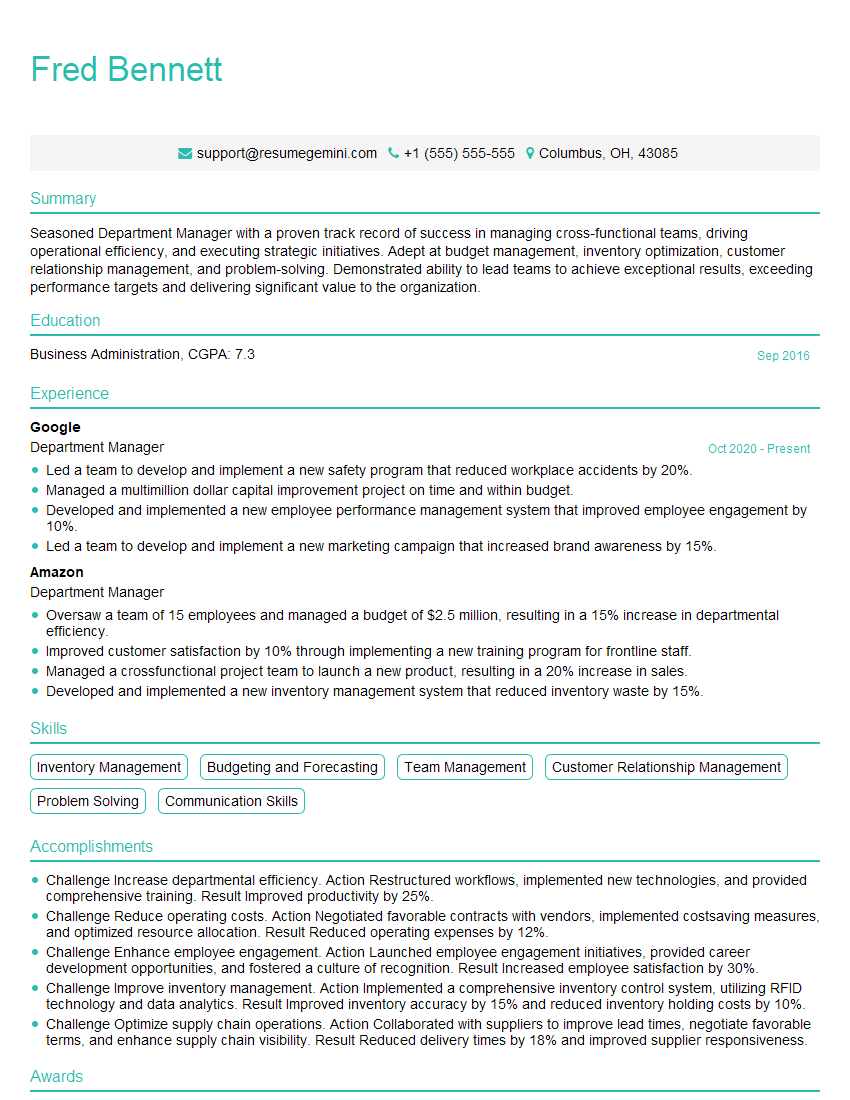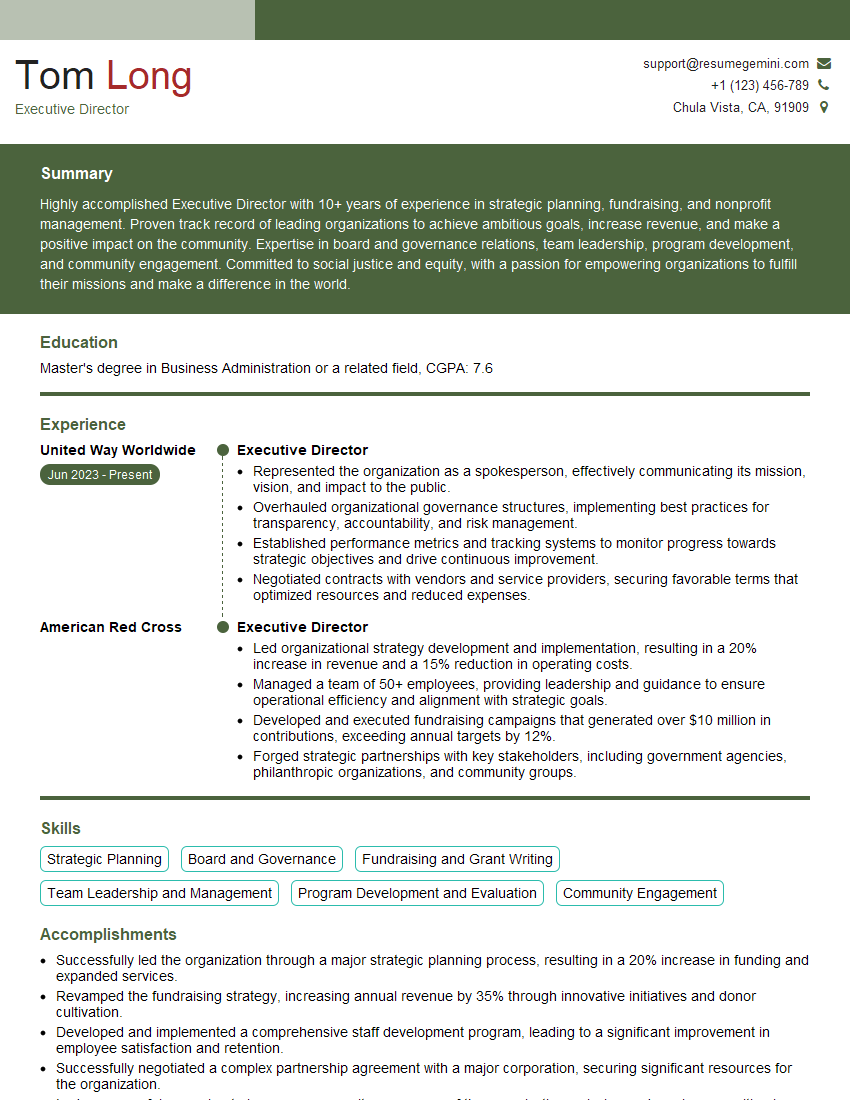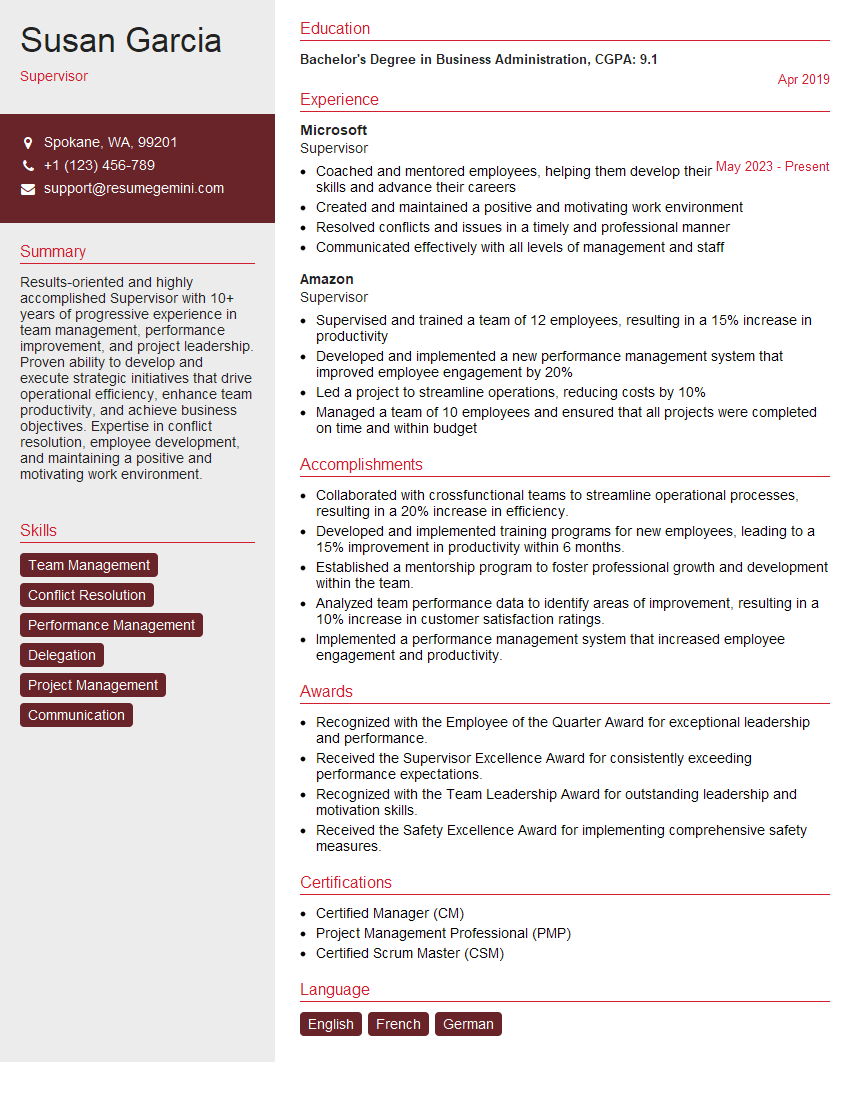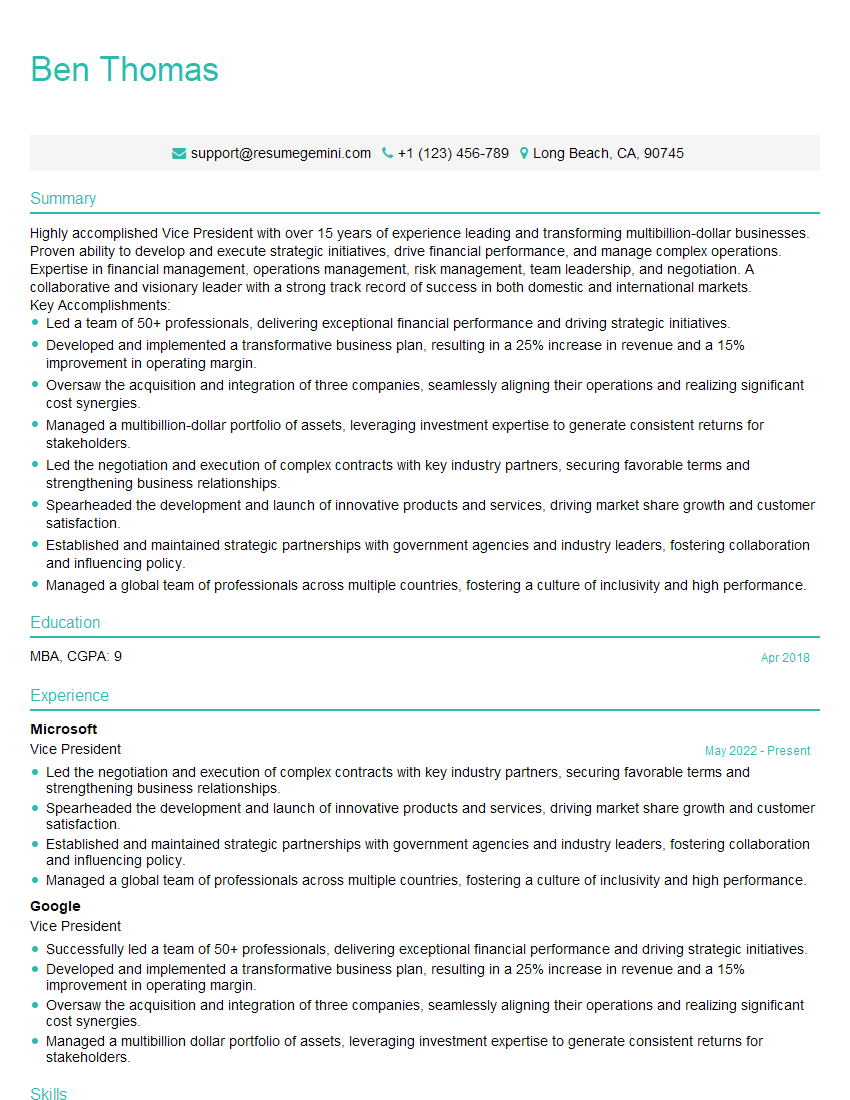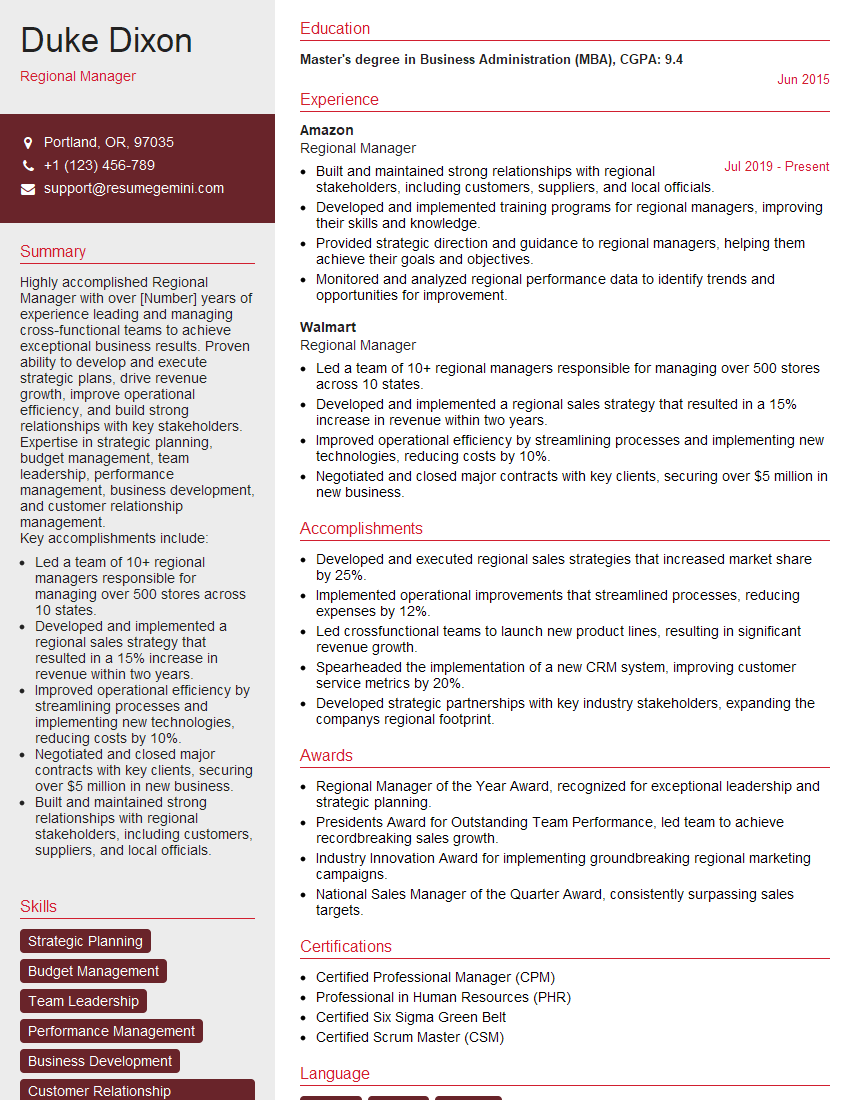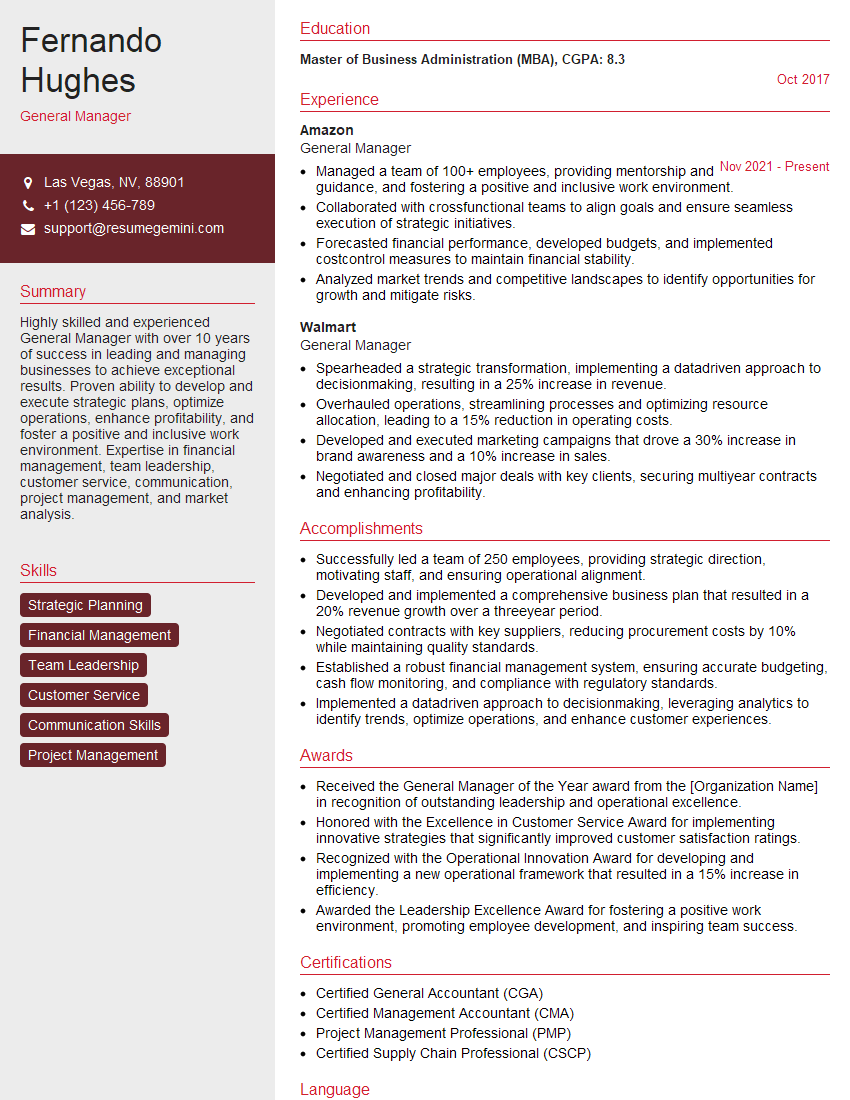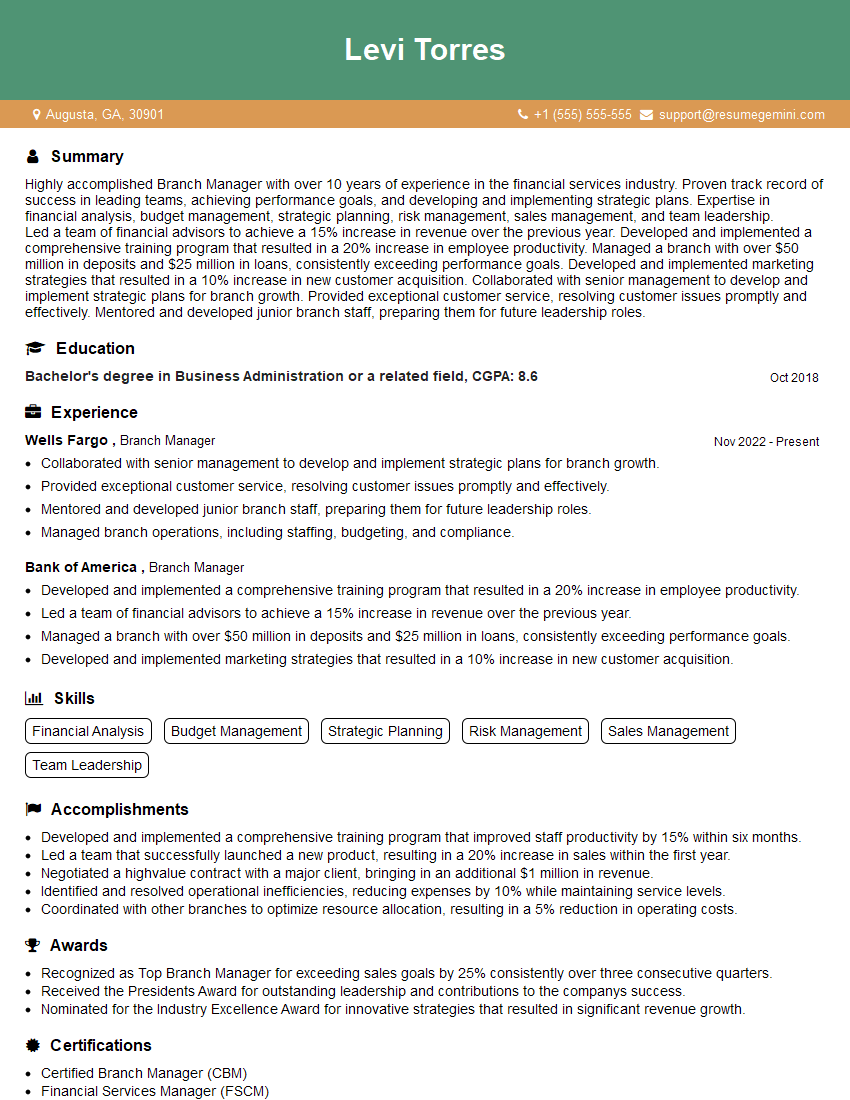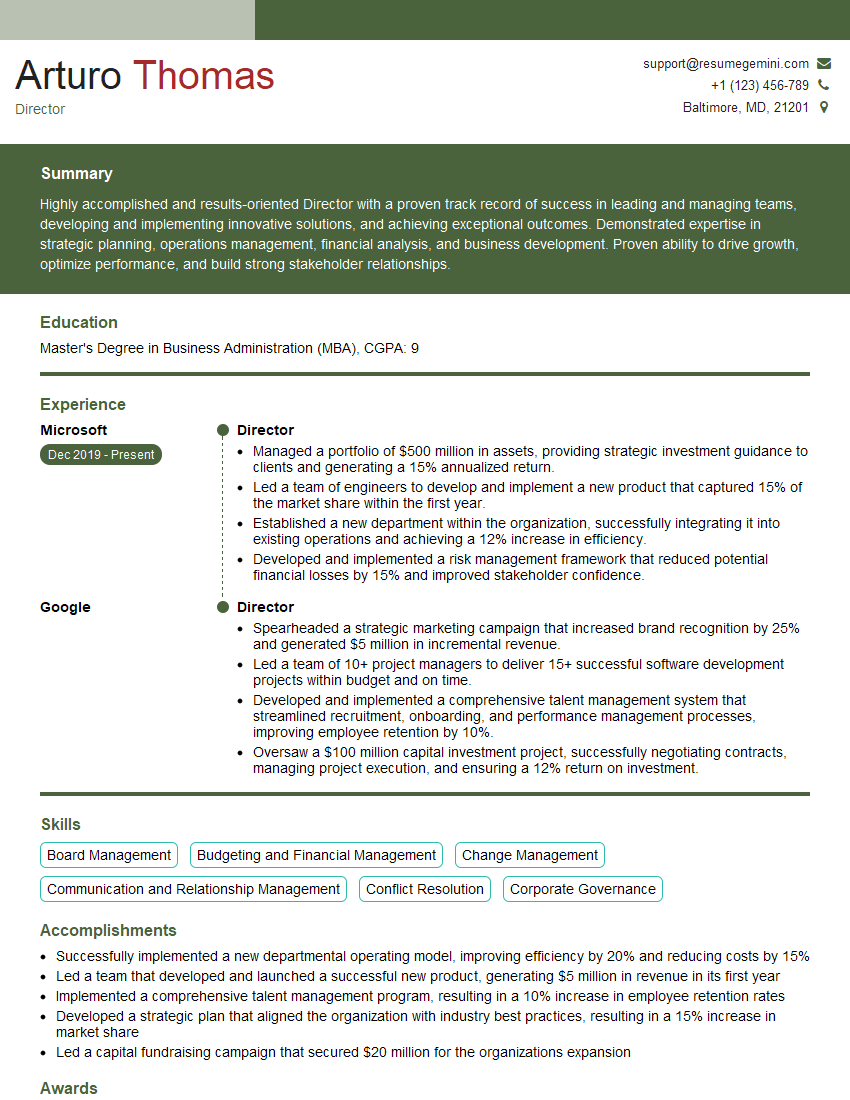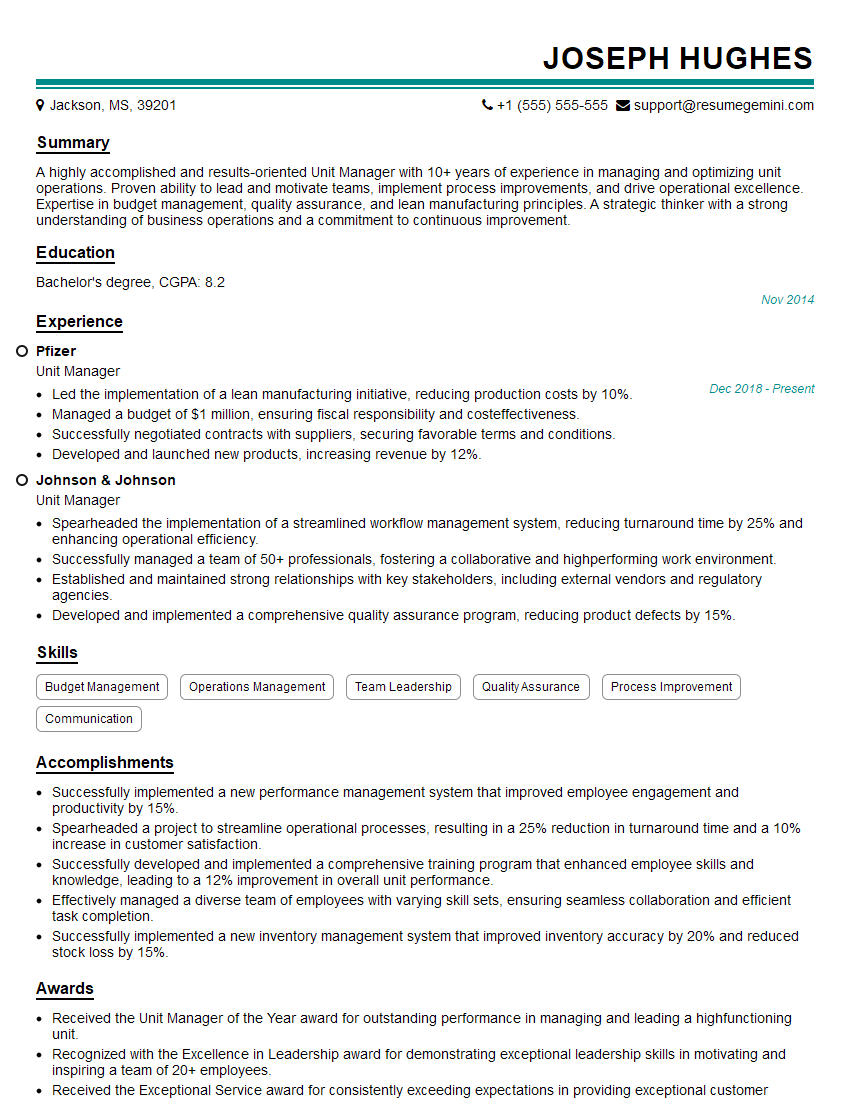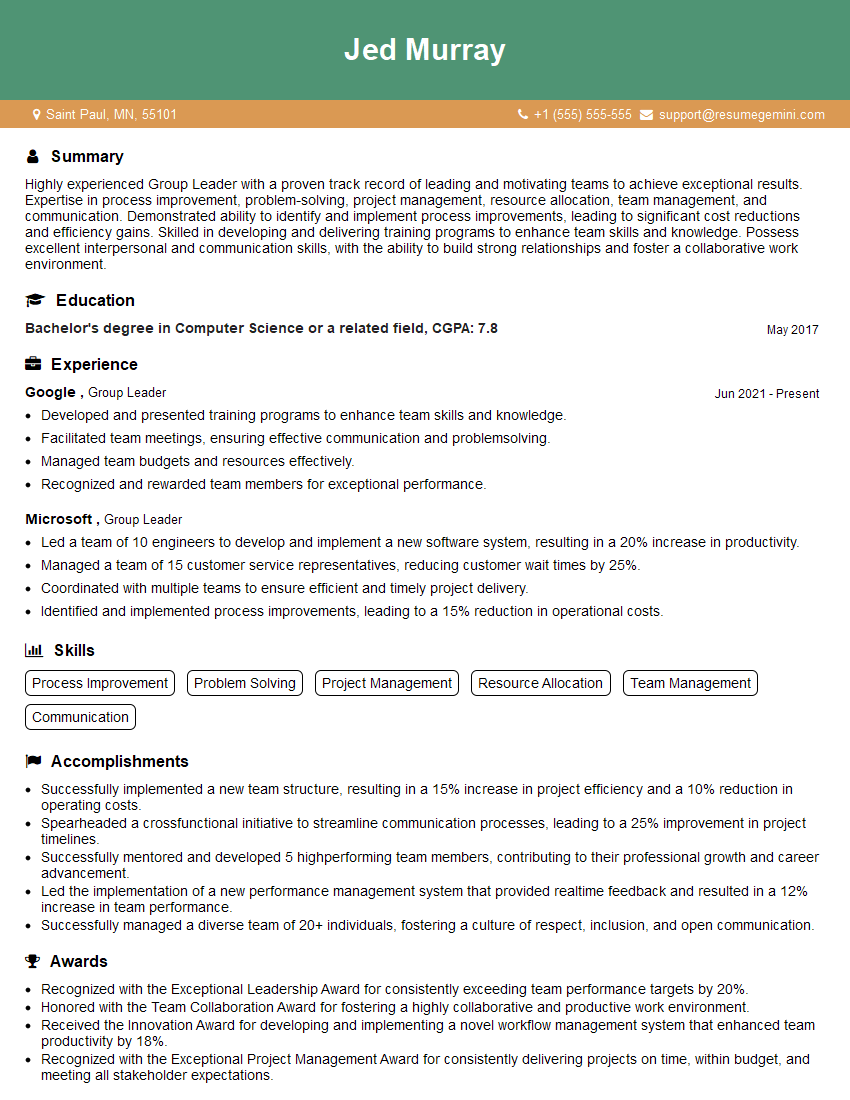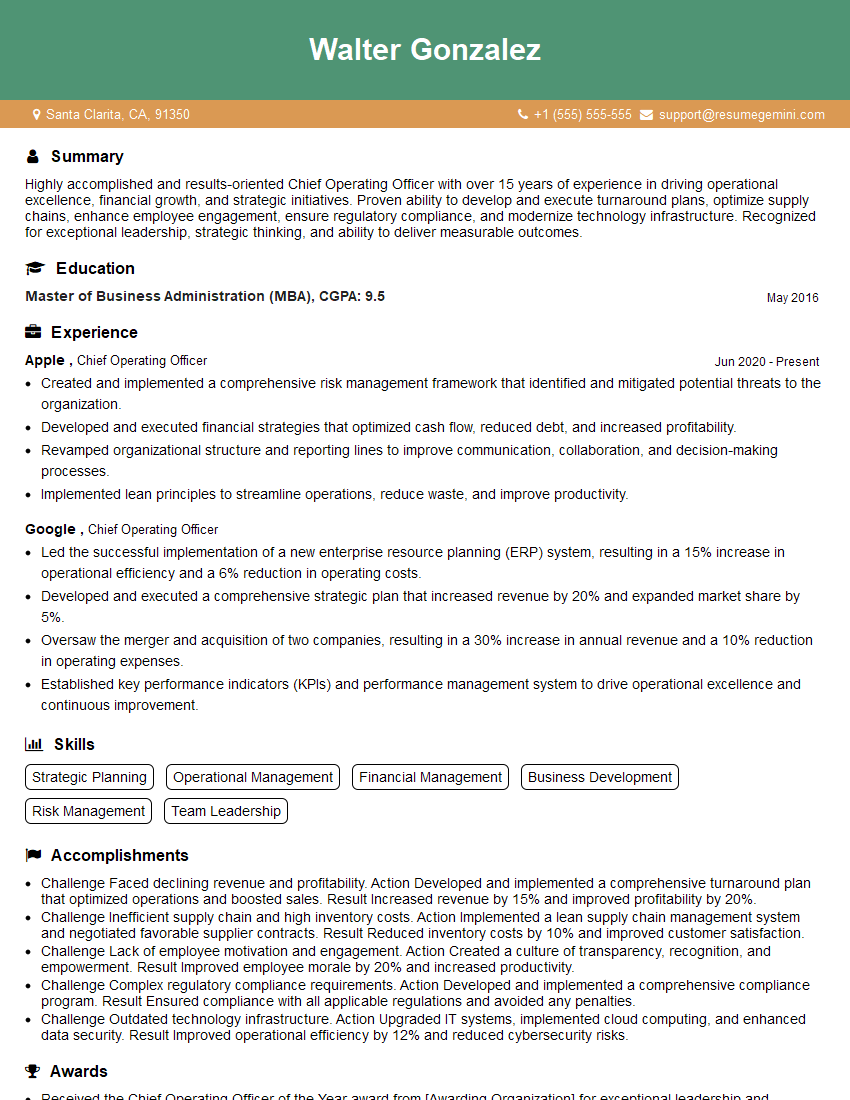Every successful interview starts with knowing what to expect. In this blog, we’ll take you through the top Ability to Supervise and Motivate Teams interview questions, breaking them down with expert tips to help you deliver impactful answers. Step into your next interview fully prepared and ready to succeed.
Questions Asked in Ability to Supervise and Motivate Teams Interview
Q 1. Describe your approach to delegating tasks within a team.
My approach to delegation prioritizes both the task and the individual team member’s strengths and development needs. I don’t simply assign tasks; I carefully consider who is best suited for each based on their skills, experience, and capacity. This involves a three-step process:
- Assessment: I thoroughly analyze the task, identifying the required skills, complexity, and deadline. I then assess each team member’s capabilities and workload.
- Matching: I strategically assign tasks, matching individual skills to task requirements. Where possible, I assign tasks that will help team members grow professionally. For example, I might assign a more junior member a simpler aspect of a project with clear guidance, allowing them to learn and develop.
- Empowerment: Once the task is assigned, I empower the team member with the necessary autonomy and resources. This includes providing clear instructions, setting realistic expectations, and offering ongoing support and feedback, but without micromanaging.
For instance, during a recent website redesign project, I assigned the front-end development to a more experienced team member, knowing their expertise in that area. I then delegated the back-end to a junior developer, pairing them with a senior mentor for guidance. This fostered both efficient project completion and the professional growth of a team member.
Q 2. How do you identify and address individual team member performance issues?
Addressing performance issues requires a sensitive and proactive approach. I start by identifying the root cause. Is it a lack of skills, insufficient resources, unclear expectations, or something else? My process involves:
- Observation & Documentation: I carefully observe the team member’s performance, noting specific instances of underperformance. I maintain detailed and objective documentation.
- Private Conversation: I schedule a private meeting with the individual to discuss my observations, focusing on specific behaviors and their impact. I use a positive and constructive tone, encouraging open communication.
- Collaboration & Solutions: We work together to identify potential solutions. This may involve additional training, mentorship, adjusted workloads, or clarifying expectations. The goal is to empower them to succeed.
- Follow-up & Support: Regular follow-up is crucial to track progress and provide continued support. I offer ongoing encouragement and celebrate successes along the way.
For example, if a team member consistently misses deadlines, I would first investigate whether it’s due to an unrealistic workload, lack of clarity on priorities, or a need for time management training. The solution wouldn’t be simply a reprimand, but a collaborative effort to address the underlying issue.
Q 3. Explain your method for setting clear expectations and goals for your team.
Setting clear expectations and goals is fundamental to a high-performing team. I use the SMART goal framework: Specific, Measurable, Achievable, Relevant, and Time-bound. The process starts with:
- Team Involvement: I actively involve the team in the goal-setting process, fostering ownership and buy-in. This ensures the goals are not just imposed but collaboratively defined.
- SMART Goals: Each goal is clearly articulated using the SMART framework. For example, instead of ‘Improve website traffic,’ a SMART goal would be ‘Increase website traffic by 20% in the next quarter by implementing SEO optimization techniques.’
- Regular Check-ins: Regular check-in meetings are conducted to monitor progress, identify obstacles, and make necessary adjustments. These aren’t just performance reviews; they are collaborative problem-solving sessions.
- Open Communication: I maintain open communication channels, ensuring transparency and immediate feedback loops. This allows for real-time adjustments and prevents misunderstandings.
This collaborative approach makes everyone feel invested in the success of the team and the achievement of the goals.
Q 4. How do you foster a positive and collaborative team environment?
Fostering a positive and collaborative team environment is crucial. My approach is built on:
- Respect & Trust: Creating a culture of mutual respect and trust is paramount. This means valuing diverse perspectives, actively listening to team members, and ensuring everyone feels safe to share ideas and concerns.
- Open Communication: Regular team meetings, both formal and informal, are essential to encourage open communication and information sharing. This prevents misunderstandings and fosters a sense of unity.
- Team-Building Activities: I regularly organize team-building activities to encourage bonding and collaboration. These activities can range from informal lunches to more structured team-building exercises.
- Recognition & Appreciation: Recognizing and appreciating individual and team contributions is vital to boosting morale and motivation. This can involve verbal praise, public acknowledgment, or small rewards.
Think of it like building a strong foundation for a house. Without respect, trust, and open communication, the team lacks stability and collaboration.
Q 5. Describe a time you had to motivate a team facing a challenging project.
During a particularly challenging project involving the launch of a new software application under a tight deadline, my team encountered significant technical difficulties. Morale was low, and the deadline seemed unattainable. To motivate them, I employed several strategies:
- Reframing the Challenge: I reframed the challenges as opportunities for growth and learning, emphasizing the impact our work would have on users.
- Increased Communication: I increased the frequency of communication, holding daily stand-up meetings to track progress, address concerns, and foster a sense of shared purpose.
- Team Support: I fostered a supportive environment where team members felt comfortable asking for help and sharing their struggles. I actively sought ways to alleviate their workload when possible.
- Celebrating Small Wins: We celebrated every milestone achieved, no matter how small. This helped maintain momentum and positive reinforcement.
By fostering a supportive and collaborative environment and recognizing their dedication and resilience, we were able to overcome the challenges and successfully launch the application, albeit a bit behind schedule. The experience strengthened the team and increased their collective confidence.
Q 6. How do you handle conflicts within a team?
Handling conflicts requires a neutral and impartial approach focused on resolving the issue, not assigning blame. My approach involves:
- Active Listening: I start by actively listening to each party’s perspective, allowing them to fully express their views without interruption.
- Identifying the Root Cause: I work to identify the underlying cause of the conflict, moving beyond superficial arguments to understand the core issue.
- Mediation & Facilitation: I facilitate a constructive dialogue, helping the parties find common ground and collaboratively develop solutions.
- Agreement & Follow-up: Once a solution is reached, I ensure a clear agreement is documented, and I follow up to ensure the solution is effective and the conflict doesn’t resurface.
Sometimes, formal mediation techniques, such as focusing on interests rather than positions, are useful. The key is to create a safe space for open communication and collaborative problem-solving.
Q 7. What strategies do you use to provide constructive feedback to team members?
Providing constructive feedback is crucial for growth and development. My approach focuses on being specific, timely, and balanced, employing the SBI (Situation-Behavior-Impact) method:
- Situation: I clearly describe the specific situation or event I’m referencing. This provides context and avoids ambiguity.
- Behavior: I objectively describe the behavior observed, focusing on observable actions rather than subjective judgments.
- Impact: I explain the impact of the behavior, both positive and negative, on the team and the project. This helps the individual understand the consequences of their actions.
- Focus on Improvement: I frame the feedback in terms of improvement, offering specific suggestions and actionable steps for development. I focus on what they can do to improve.
For example, instead of saying ‘Your work is sloppy,’ I would say, ‘During the last sprint, the code you submitted for module X had three minor bugs that resulted in a delay of the testing phase by half a day. Let’s work together to identify ways to improve your testing process before submitting code.’ This provides concrete examples and focuses on a solution-oriented approach.
Q 8. How do you measure the success of your team’s performance?
Measuring team success goes beyond simply achieving targets; it’s about evaluating overall performance and impact. I use a multi-faceted approach, combining quantitative and qualitative data. Quantitatively, I track key performance indicators (KPIs) relevant to the team’s goals, such as project completion rates, customer satisfaction scores, efficiency metrics, and revenue generated. For example, if we’re launching a new product, KPIs might include on-time delivery, budget adherence, and pre-orders. However, numbers alone don’t tell the whole story. Qualitatively, I assess team dynamics through regular check-ins, feedback sessions, and anonymous surveys to gauge team morale, collaboration effectiveness, and individual contributions. I look for signs of improved team cohesion, proactive problem-solving, and a positive work environment. Combining these quantitative and qualitative measures gives a comprehensive picture of the team’s overall success and areas for improvement.
Q 9. Describe your approach to recognizing and rewarding team achievements.
Recognizing and rewarding achievements is crucial for boosting morale and fostering a culture of excellence. My approach is multifaceted and personalized. I believe in celebrating both individual and collective accomplishments. For individual achievements, I utilize both formal and informal recognition. Formal methods include performance bonuses, promotions, and public acknowledgment during team meetings. For instance, if a team member significantly exceeded expectations on a project, I might highlight their contribution in a company-wide email. Informal methods include personalized thank-you notes, expressing appreciation directly, and providing opportunities for professional development. For team accomplishments, I organize team lunches, award small gifts, or suggest a team-building activity to reinforce the sense of collaboration and shared success. For example, after a successful product launch, I might take the team out for a celebratory dinner. The key is to tailor the rewards to the individuals and the specific achievement, showing genuine appreciation for their efforts.
Q 10. How do you adapt your leadership style to different team members and situations?
Adaptability is key to effective leadership. I believe in employing a situational leadership style, adapting my approach based on the team member’s skill level, experience, and the specific situation. For example, with a highly skilled and experienced team member working on a complex project, I might adopt a delegative style, providing guidance and support but allowing them significant autonomy. With a newer team member needing more guidance, I would use a more directive style, providing clear instructions and regular feedback. During a crisis, a more directive approach might be necessary, while during routine tasks, a supportive and participative style could be more effective. I regularly assess team member needs and project demands, adjusting my communication style, support levels, and decision-making processes accordingly. Active listening and open communication are critical to understanding the needs of each individual and the dynamics of the team as a whole.
Q 11. How do you handle situations where a team member consistently underperforms?
Addressing underperformance requires a systematic and empathetic approach. I begin with a one-on-one meeting to understand the root cause of the issue. This conversation focuses on open communication and collaborative problem-solving. I explore whether there are external factors such as lack of resources, unclear expectations, or personal issues affecting their performance. Once I understand the cause, I work with the team member to develop a performance improvement plan (PIP) with specific, measurable, achievable, relevant, and time-bound (SMART) goals. This plan outlines the steps needed to improve performance, providing clear expectations and support. Regular check-ins are crucial to monitor progress and offer ongoing support and coaching. If the underperformance persists despite the PIP, more serious actions, including disciplinary measures, might unfortunately be necessary. The goal throughout is to support the individual while ensuring the overall team’s productivity and standards are maintained.
Q 12. How do you build trust and rapport with your team members?
Building trust and rapport involves consistent effort and genuine care. I prioritize open communication, transparency, and active listening. I make myself accessible to my team members and encourage them to share their concerns and ideas without fear of judgment. I demonstrate vulnerability by sharing relevant personal experiences (while maintaining professional boundaries) to create a sense of connection and shared humanity. I also lead by example, exhibiting integrity, accountability, and consistency in my actions. Building trust takes time; it’s a gradual process of demonstrating reliability, competence, and respect for each team member. Recognizing individual contributions and celebrating successes – both big and small – also fosters a sense of value and belonging within the team. Taking an interest in my team members’ personal and professional lives (without being intrusive) can help strengthen those bonds and build mutual respect.
Q 13. How do you encourage open communication and feedback within your team?
Encouraging open communication and feedback is essential for a high-performing team. I establish a culture of psychological safety where team members feel comfortable sharing their thoughts and opinions without fear of reprimand. I actively solicit feedback through regular team meetings, one-on-one check-ins, and anonymous surveys. I ensure that feedback is constructive and focused on improvement, not on personal attacks. I use various communication tools, including project management software, instant messaging, and regular email updates to keep everyone informed and involved. I actively model open communication by sharing my own thoughts and feelings honestly and transparently. Regular feedback sessions, both formally and informally, provide a structured opportunity for open discussion and mutual learning. This process creates a more collaborative and efficient work environment where ideas are freely exchanged, and problems are addressed proactively.
Q 14. Describe a time you had to make a difficult decision that impacted your team.
In a previous role, we faced a significant budget cut that necessitated reducing our team size. This was an incredibly difficult decision with significant emotional impact on the team. My approach focused on transparency and fairness. I involved the team in the decision-making process as much as possible, explaining the situation openly and honestly. We created a framework for evaluating roles based on objective criteria, avoiding subjective biases. This process allowed the team to understand the rationale behind the choices, reducing uncertainty and fostering a sense of fairness. We prioritized retaining individuals with critical skills and experience, while ensuring support for those leaving the team through outplacement services and career counseling. While painful, this open and empathetic approach helped to navigate a difficult situation and maintain a sense of trust and respect within the remaining team.
Q 15. How do you ensure your team stays organized and on track?
Keeping a team organized and on track involves a multifaceted approach that blends clear communication, effective tools, and proactive management. I begin by establishing clear goals and expectations, ensuring every team member understands their individual roles and how they contribute to the overall objectives. This clarity is often achieved through a well-defined project plan, regularly updated and shared using collaborative tools.
Secondly, I implement a system for tracking progress. This might involve daily stand-up meetings, weekly progress reports, or the use of project management software like Jira or Asana to visualize tasks, deadlines, and dependencies. Regular check-ins allow me to identify potential roadblocks early and provide support or adjust plans as needed. For example, in my previous role, we used a Kanban board to track the progress of our software development sprints, allowing for transparent visibility and quick identification of bottlenecks. This proactive approach prevents minor issues from escalating into major problems, keeping the team on schedule and reducing stress.
Finally, I foster a culture of open communication where team members feel comfortable raising concerns or seeking clarification. This open dialogue is crucial for ensuring everyone is aligned and working towards the same goals. I encourage regular team meetings – both formal and informal – to discuss progress, address challenges, and celebrate successes. This helps build team cohesion and keeps everyone motivated and informed.
Career Expert Tips:
- Ace those interviews! Prepare effectively by reviewing the Top 50 Most Common Interview Questions on ResumeGemini.
- Navigate your job search with confidence! Explore a wide range of Career Tips on ResumeGemini. Learn about common challenges and recommendations to overcome them.
- Craft the perfect resume! Master the Art of Resume Writing with ResumeGemini’s guide. Showcase your unique qualifications and achievements effectively.
- Don’t miss out on holiday savings! Build your dream resume with ResumeGemini’s ATS optimized templates.
Q 16. What are your preferred methods for providing training and development to team members?
My approach to training and development is personalized and multifaceted, focusing on both individual needs and team-wide skill enhancement. I start by identifying skill gaps through performance reviews, observation, and open communication with team members. This allows me to tailor training programs to address specific weaknesses and capitalize on strengths.
My preferred methods include a combination of on-the-job training, mentorship programs, and external workshops or online courses. On-the-job training is crucial for practical skill development, where I provide guidance and support as team members tackle real-world projects. Mentorship pairs experienced team members with newer ones, facilitating knowledge transfer and fostering a supportive learning environment. External resources are valuable for specialized skills or broader professional development.
For example, when a team member struggled with data analysis, I paired them with a senior analyst for mentorship and also enrolled them in an online data visualization course. This blended approach ensures both practical application and theoretical understanding. Regular feedback and performance reviews are essential to track progress and adjust the training plan as needed, ensuring continuous improvement.
Q 17. How do you manage your time effectively when supervising a team?
Effective time management when supervising a team relies on prioritization, delegation, and efficient use of technology. I begin by clearly defining priorities, focusing on tasks that directly impact team goals and deadlines. This often involves using tools like Eisenhower Matrix (urgent/important) to categorize tasks and allocate time appropriately.
Delegation is crucial. I empower team members by assigning tasks that align with their skills and development goals. This not only frees up my time but also enhances team members’ skills and confidence. I provide clear instructions, set expectations, and offer support as needed, but avoid micromanaging.
Finally, I utilize technology to streamline communication and workflow. This includes using project management software, scheduling tools, and instant messaging apps to reduce the time spent on administrative tasks. Regularly reviewing my schedule and prioritizing tasks keeps me focused and productive, allowing for effective supervision without sacrificing personal time.
Q 18. How do you utilize technology to improve team collaboration and productivity?
Technology plays a vital role in enhancing team collaboration and productivity. I leverage a range of tools to facilitate seamless communication, efficient task management, and improved knowledge sharing. For example, project management software like Asana or Trello enables centralized task management, tracking progress, and facilitating collaboration on projects.
Communication tools such as Slack or Microsoft Teams improve instant messaging, file sharing, and video conferencing, allowing for quick responses to queries and efficient information dissemination. Cloud-based storage services, such as Google Drive or Dropbox, simplify file sharing and version control, eliminating confusion and ensuring everyone works with the latest documents. Video conferencing tools, like Zoom or Google Meet, facilitate remote collaboration and team meetings, regardless of location.
In addition, I often utilize collaborative document editing tools, such as Google Docs or Microsoft Word Online, to facilitate real-time teamwork on presentations, reports, and other documents. This eliminates the need for multiple versions and ensures everyone is working with the most updated information. The careful selection and implementation of these technologies ensure seamless teamwork, increasing efficiency and overall productivity.
Q 19. How do you handle pressure and stress while leading a team?
Handling pressure and stress while leading a team requires a proactive and multifaceted approach. I start by prioritizing self-care, recognizing that my own well-being is essential for effectively supporting my team. This includes maintaining a healthy work-life balance, getting enough sleep, and engaging in stress-reducing activities.
Secondly, I foster a supportive and collaborative team environment where open communication is encouraged. This allows team members to share their concerns and challenges, creating a sense of shared responsibility and reducing individual stress levels. I actively encourage breaks, allowing time for team members to recharge and prevent burnout.
When facing significant pressure, I employ problem-solving strategies, breaking down complex challenges into smaller, manageable tasks. This reduces feelings of overwhelm and allows for focused action. I also regularly review and adjust priorities, ensuring we are focused on the most crucial tasks. Finally, I celebrate successes, both big and small, to maintain morale and reinforce a positive work environment.
Q 20. Describe your experience with performance management systems.
My experience with performance management systems encompasses a holistic approach focused on both feedback and development. I’ve utilized various systems, ranging from simple performance review forms to more sophisticated software-based platforms that track key performance indicators (KPIs).
Regardless of the specific system used, my approach centers on regular and constructive feedback. This involves conducting frequent check-ins with team members to discuss progress, address concerns, and provide guidance. Performance reviews are not just annual events but a continuous process of monitoring and supporting employee growth. I use these reviews to identify areas of strength and areas for improvement, developing personalized development plans to address skill gaps or enhance performance.
I believe in focusing on specific behaviors and accomplishments rather than vague assessments. For example, instead of saying ‘improve communication skills’, I would provide specific examples of effective communication and suggest strategies for improvement. I also ensure that performance management is a two-way process, encouraging open communication and allowing team members to provide feedback on the team’s performance and their own development needs. This ensures that the system is fair, transparent, and ultimately contributes to employee growth and team success.
Q 21. How do you handle criticism from team members?
Handling criticism from team members requires active listening, empathy, and a commitment to addressing concerns constructively. I start by actively listening to the criticism, without interrupting or becoming defensive. I try to understand the underlying reason for the criticism, seeking to clarify any misunderstandings.
Once I understand the perspective, I express empathy and validate the team member’s feelings. Even if I don’t agree with the criticism, acknowledging their perspective demonstrates respect and encourages open communication. Then, I address the criticism constructively, either by agreeing to make changes or explaining why a particular approach was chosen. If the criticism is valid, I take steps to address the issue and make necessary changes. If not, I clearly explain my rationale and look for opportunities to improve communication and mutual understanding.
For instance, if a team member criticizes a decision, I might explain the reasoning behind it, acknowledging their concerns and offering to explain the process in more detail. If the feedback highlights a recurring issue, I might adjust processes or workflows to address the underlying problem. It’s critical to use criticism as an opportunity to improve both the team’s work and the working relationship.
Q 22. How do you stay up-to-date on industry trends and best practices in team management?
Staying current in team management requires a multifaceted approach. I actively participate in professional development opportunities like conferences (SHRM, ATD) and webinars focusing on leadership and team dynamics. I also subscribe to relevant journals and industry publications such as Harvard Business Review and Fast Company, which provide insights into cutting-edge strategies and research. Furthermore, I leverage online platforms like LinkedIn Learning and Coursera to access specialized courses on topics such as emotional intelligence, conflict resolution, and change management. Finally, I actively engage in professional networks, participating in discussions and exchanging ideas with other leaders in my field. This constant learning ensures I’m equipped with the latest best practices and adapt my approach as the landscape evolves.
Q 23. How do you handle situations where team members have conflicting priorities?
Conflicting priorities are inevitable in fast-paced environments. My approach is to first clearly understand each team member’s individual priorities and the underlying reasons for the conflict. I facilitate open communication through a collaborative meeting where each team member articulates their tasks, deadlines, and constraints. We then prioritize tasks using methods like a weighted scoring system or a simple prioritization matrix, based on urgency, impact, and alignment with overall team goals. This ensures transparency and shared understanding. If the conflict persists, I might consider resource allocation adjustments or re-negotiation of deadlines, always keeping the larger organizational goals in mind. For example, in a previous project, two team members were vying for the same resources to meet their individual deadlines. By using a prioritization matrix that weighed the strategic impact of each task, we identified one task as higher priority and reallocated resources accordingly, ultimately resolving the conflict and keeping the project on schedule.
Q 24. How do you ensure diversity and inclusion within your team?
Diversity and inclusion are paramount to building high-performing teams. I begin by ensuring fair and equitable hiring practices, actively seeking candidates from diverse backgrounds. Then, I create a culture of inclusivity by actively listening to and valuing diverse perspectives. I implement inclusive communication strategies, ensuring everyone feels comfortable expressing their ideas. Regular team-building activities that celebrate differences are crucial. For example, I’ve organized team-building events around celebrating different cultures, including food tastings and cultural presentations. Finally, I provide regular training on unconscious bias and cultural sensitivity to foster a more inclusive workplace. This comprehensive approach creates a safe and welcoming environment where every team member feels valued and respected, maximizing their potential.
Q 25. What is your approach to building a strong team culture?
A strong team culture is built on trust, respect, and shared values. I start by establishing clear team goals and expectations, ensuring everyone understands their contribution to the overall success. I encourage open communication and feedback through regular team meetings and informal check-ins, making sure that constructive feedback is consistently given and received. I celebrate team achievements, both big and small, fostering a sense of accomplishment and shared success. I also promote work-life balance and create a supportive environment where team members feel comfortable supporting each other. For instance, I encourage peer mentoring and knowledge sharing, building a strong sense of camaraderie and mutual support. This holistic approach fosters a positive, productive, and engaging work environment.
Q 26. Describe your experience with mentoring and coaching team members.
Mentoring and coaching are integral parts of my leadership style. My approach is tailored to individual needs, focusing on both skill development and personal growth. I use a combination of techniques, including regular one-on-one meetings, constructive feedback, and goal-setting. I act as a sounding board, offering guidance and support while empowering team members to identify and solve their own challenges. For example, I recently mentored a junior team member who lacked confidence in public speaking. Through a series of coaching sessions, focusing on practice and positive reinforcement, I helped her successfully deliver a presentation at a major client meeting. This experience not only boosted her professional skills but also significantly increased her confidence and overall job satisfaction.
Q 27. How do you identify and develop future team leaders within your team?
Identifying and developing future leaders involves a proactive and multi-stage approach. I observe team members’ performance, looking for individuals who demonstrate leadership qualities such as initiative, problem-solving skills, and a commitment to team success. I then provide these individuals with opportunities to take on increasing responsibility, such as leading sub-projects or mentoring junior colleagues. I also offer them opportunities for training and development in leadership skills, including workshops and mentoring from senior leaders. Regular feedback and coaching sessions are essential to track their progress and provide constructive guidance. By providing these opportunities, I cultivate a pipeline of future leaders within the team, ensuring continuity and growth.
Q 28. Describe a time you had to navigate a significant team restructuring.
During a recent company restructuring, my team experienced significant changes. My priority was to maintain transparency and communication throughout the process. I held open forums to address concerns and answer questions honestly. I worked closely with HR to ensure a smooth transition for affected employees, providing support and resources during this challenging time. I focused on re-organizing the team to maintain productivity and morale, creating new roles and responsibilities to reflect the new structure. I also emphasized the importance of adapting to change and maintaining a positive attitude. This proactive approach minimized disruption and ensured the team continued to perform effectively despite the significant organizational changes. By focusing on open communication, support, and proactive adaptation, we navigated the restructuring successfully and emerged stronger as a team.
Key Topics to Learn for Ability to Supervise and Motivate Teams Interview
- Understanding Team Dynamics: Learn to identify different team personalities and communication styles. Consider how individual strengths and weaknesses contribute to overall team performance.
- Effective Communication Strategies: Practice clear, concise, and empathetic communication. Explore techniques for active listening, providing constructive feedback, and addressing conflict resolution.
- Delegation and Empowerment: Master the art of delegating tasks effectively, matching responsibilities to individual team members’ skills and capabilities. Understand how to empower your team to take ownership and initiative.
- Motivation and Recognition: Explore various motivational theories and practical strategies for boosting team morale. Learn to identify and celebrate individual and team accomplishments.
- Performance Management: Understand how to set clear expectations, provide regular feedback, conduct performance reviews, and address performance issues constructively and fairly.
- Conflict Resolution and Team Building: Develop strategies for proactively addressing conflicts, mediating disputes, and fostering a positive and collaborative team environment. Explore team-building activities and strategies.
- Leading Through Change: Learn how to effectively communicate changes, manage resistance, and maintain team morale during periods of transition or uncertainty.
- Goal Setting and Achievement: Master the process of setting SMART goals (Specific, Measurable, Achievable, Relevant, Time-bound) and tracking progress towards achieving them as a team.
Next Steps
Mastering the ability to supervise and motivate teams is crucial for career advancement. Strong leadership skills are highly sought after, opening doors to greater responsibility and higher earning potential. To maximize your job prospects, it’s vital to present your skills effectively. Creating an ATS-friendly resume is key to ensuring your application gets noticed by recruiters. ResumeGemini can help you build a compelling resume that highlights your leadership abilities and experience in supervising and motivating teams. Examples of resumes tailored to showcase your “Ability to Supervise and Motivate Teams” are available within ResumeGemini to further enhance your application materials.
Explore more articles
Users Rating of Our Blogs
Share Your Experience
We value your feedback! Please rate our content and share your thoughts (optional).
What Readers Say About Our Blog
Hello,
We found issues with your domain’s email setup that may be sending your messages to spam or blocking them completely. InboxShield Mini shows you how to fix it in minutes — no tech skills required.
Scan your domain now for details: https://inboxshield-mini.com/
— Adam @ InboxShield Mini
Reply STOP to unsubscribe
Hi, are you owner of interviewgemini.com? What if I told you I could help you find extra time in your schedule, reconnect with leads you didn’t even realize you missed, and bring in more “I want to work with you” conversations, without increasing your ad spend or hiring a full-time employee?
All with a flexible, budget-friendly service that could easily pay for itself. Sounds good?
Would it be nice to jump on a quick 10-minute call so I can show you exactly how we make this work?
Best,
Hapei
Marketing Director
Hey, I know you’re the owner of interviewgemini.com. I’ll be quick.
Fundraising for your business is tough and time-consuming. We make it easier by guaranteeing two private investor meetings each month, for six months. No demos, no pitch events – just direct introductions to active investors matched to your startup.
If youR17;re raising, this could help you build real momentum. Want me to send more info?
Hi, I represent an SEO company that specialises in getting you AI citations and higher rankings on Google. I’d like to offer you a 100% free SEO audit for your website. Would you be interested?
Hi, I represent an SEO company that specialises in getting you AI citations and higher rankings on Google. I’d like to offer you a 100% free SEO audit for your website. Would you be interested?
good
